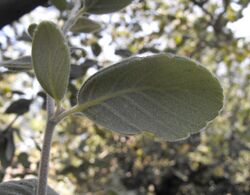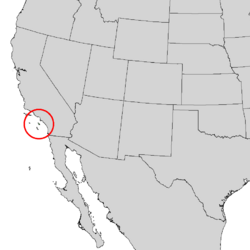Biology:Cercocarpus traskiae
| Santa Catalina Island mountain-mahogany | |
|---|---|

| |
| Scientific classification | |
| Kingdom: | Plantae |
| Clade: | Tracheophytes |
| Clade: | Angiosperms |
| Clade: | Eudicots |
| Clade: | Rosids |
| Order: | Rosales |
| Family: | Rosaceae |
| Genus: | Cercocarpus |
| Species: | C. traskiae
|
| Binomial name | |
| Cercocarpus traskiae Eastw.
| |

| |
| Natural range of Cercocarpus traskiae | |
Cercocarpus traskiae, known by the common names Santa Catalina Island mountain-mahogany and Catalina mahogany, is a rare species of plant in the rose family.
Distribution
It is endemic to Catalina Island, one of the southern Channel Islands in Los Angeles County, California . It is known from just a single population,[2] found in Wild Boar Gully, an arroyo covered in coastal sage scrub on Catalina Island.[3] The steep sides of the arroyo contain soils of saussurite gabbro.[2][3]
It was rare at the time of its discovery by Blanche Trask in 1897[4] or 1898,[2] when about 40[4] to 50[2] plants were counted.[3]
When it was federally listed as an endangered species, in 1996, there were only six mature plants remaining.[2] It has been called "one of the rarest shrubs in the continental United States"[4] and "one of the rarest trees in North America."[3]
Description
Cercocarpus traskiae is a large shrub or tree that grows up to 8 meters in height. The leaves have thick, leathery oval blades with serrated edges and woolly-haired undersides. The leathery, woolly texture of the leaves distinguishes it from other Cercocarpus.[5] The inflorescence is a cluster of up to 10 flowers which do not have petals. Plants do not always flower each year.[3]
While there are sometimes many seedlings noted, the seedling survival rate and rate of recruitment are quite low.[3] As of 2007, there are only seven adult trees capable of reproduction, all located in Wild Boar Gully, and most of these are very old.[3]
Conservation
The Catalina Island mountain mahogany is threatened by ungulates such as deer, and feral goats and pigs.[3] Introduced goats have been removed from the island. Introduced Mule deer remain on Catalina Island and may threaten the survival of the species.[6] Fencing has been placed to prevent the remaining animals from touching the plants.[3]
This rare species hybridizes with its relative, Cercocarpus betuloides, a situation that may lead to genetic swamping of the rare plant.[5] This hybridization may be made more likely by the animals' disturbance of the habitat.[3] Many of the seedlings and saplings growing today may be hybrids.[3]
The population of pure Cercocarpus traskiae is not increasing and the species is entirely dependent on human intervention today.[3][1]
See also
- Chaparral
- California chaparral and woodlands
References
- ↑ 1.0 1.1 World Conservation Monitoring Centre (1998). "Cercocarpus traskiae". IUCN Red List of Threatened Species 1998: e.T37562A10058133. doi:10.2305/IUCN.UK.1998.RLTS.T37562A10058133.en. https://www.iucnredlist.org/species/37562/10058133. Retrieved 17 November 2021.
- ↑ 2.0 2.1 2.2 2.3 2.4 "Comprehensive Report Species - Cercocarpus traskiae". NatureServe. The Nature Conservancy. August 2010. http://www.natureserve.org/explorer/servlet/NatureServe?searchName=Cercocarpus+traskiae. Retrieved 31 January 2011.
- ↑ 3.00 3.01 3.02 3.03 3.04 3.05 3.06 3.07 3.08 3.09 3.10 3.11 USFWS. Cercocarpus traskiae Five Year Review. September 2007.
- ↑ 4.0 4.1 4.2 "National Collection of Imperiled Plants - Plant Profile: Cercocarpus traskiae". Center for Plant Conservation, Missouri Botanical Garden, St. Louis, Missouri. March 2010. Archived from the original on 2010-12-15. https://web.archive.org/web/20101215090552/http://centerforplantconservation.org/Collection/CPC_ViewProfile.asp?CPCNum=872. Retrieved 31 January 2011.
- ↑ 5.0 5.1 Rieseberg, L. H. and D. Gerber. (1995). Hybridization in the Catalina Island mountain mahogany (Cercocarpus traskiae): RAPD evidence. Conservation Biology 9:1 199.
- ↑ Stapp, Paul; Hamblen, Emily; Duncan, Calvin L.; King, Julie L. (2022). "Status of the Introduced Mule Deer Population on Catalina Island, California, Based on Annual Spotlight Counts" (in en). https://escholarship.org/uc/item/847923z8.
External links
- Calflora: Cercocarpus traskiae (Catalina Island mountain mahogany)
- Jepson Manual eFlora (TJM2) treatment of Cercocarpus traskiae[yes|permanent dead link|dead link}}]
- UC Photos gallery — Cercocarpus traskiae
Wikidata ☰ Q5063954 entry
 |


